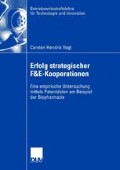Auszug
Nach den umfangreichen Vorarbeiten werden nun die Ergebnisse der eigenen empirischen Untersuchung dargestellt und erläutert. Der vorliegende Abschnitt gliedert sich in drei Bereiche. Im ersten soll der Erfolg einer Kooperation (Modell I) erklärt werden und im zweiten die Wirkung von Lerneffekten auf den Erfolg von Unternehmen (Modell II), wobei erstgenanntem eine wesentlich höhere Bedeutung zukommt. Im dritten Abschnitt werden weitergehende, separate Ergebnisse dargestellt.
Access this chapter
Tax calculation will be finalised at checkout
Purchases are for personal use only
Preview
Unable to display preview. Download preview PDF.
Literatur
Vgl. Niosi (2003), S. 742.
Vgl. Weisberg (1985), S. 118.
Vgl. Weisberg (1985), S. 15–18.
Vgl. Backhaus et al. (2003), S. 447.
Vgl. Backhaus et al. (2003), S. 445.
Vgl. Draper/ Smith (1981), S. 466–468.
Vgl. Bühl/ Zöfel (2002), S. 320f.
Vgl. Bühl/ Zöfel (2002), S. 321.
Vgl. Bühl/ Zöfel (2002), S. 321.
Vgl. Bühl/ Zöfel (2002), S. 318.
Vgl. Hagedoorn/ Schakenraad (1994), S. 300; Hagedoorn/Duysters (2002), S. 177.
Cohen/ Levinthal (1989), S. 593.
Vgl. Hagedoorn/ Duysters (2002), S. 181.
Vgl. Shan/ Walker/ Kogut (1994), S. 387.
Vgl. Hair et al. (1998), S. 193.
Vgl. Harvey (1990), S. 201.
Vgl. Albers/ Skiera (1999), S. 208.
Vgl. Backhaus et al. (2003), S. 92.
Vgl. Rindfleisch (2000), S. 85.
Vgl. Hair et al. (1998), S. 173–176.
Vgl. Rindfleisch (2000), S. 85.
Vgl. Parkhe (1993b), S. 316–319.
Vgl. Hair et al. (1998), S. 193.
Vgl. Muthusamy/ White (2005), S. 429.
Vgl. Das/ Teng (2003), S. 283; Lambe/Spekman/Hunt (2002), S. 145.
Stuart (2000), S. 809.
Vgl. Ernst (1996), S. 272f.
Rights and permissions
Copyright information
© 2007 Deutscher Universitäts-Verlag | GWV Fachverlage GmbH, Wiesbaden
About this chapter
Cite this chapter
(2007). Ergebnisse der empirischen Untersuchung. In: Erfolg strategischer F&E-Kooperationen. Gabler. https://doi.org/10.1007/978-3-8350-5533-9_5
Download citation
DOI: https://doi.org/10.1007/978-3-8350-5533-9_5
Publisher Name: Gabler
Print ISBN: 978-3-8350-0927-1
Online ISBN: 978-3-8350-5533-9
eBook Packages: Business and Economics (German Language)

